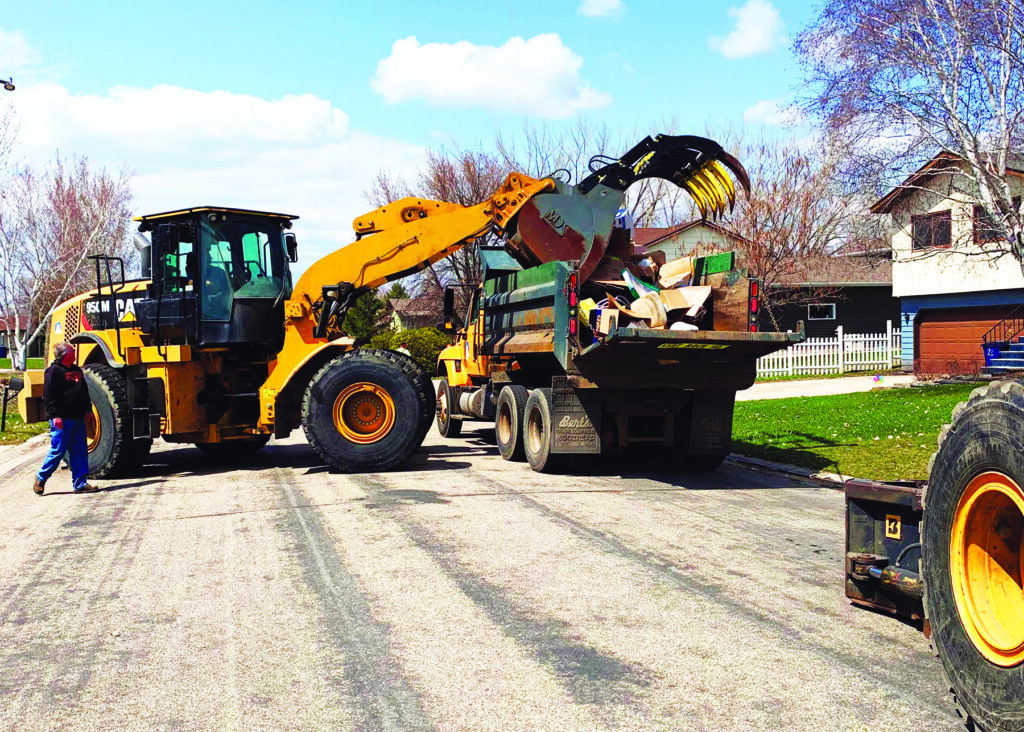
Moorhead Public Works crews pick up separated trash in different trucks — the reason it should be sorted into separate piles
Nancy Edmonds Hanson
It’s just like Christmas – but in reverse. Then, Santa and his elves load their sleigh with what good boys and girls have dreamed of. Now, the hard-working elves of Moorhead Public Works will be making their way from home to home, gathering up what their elders dream of getting rid of.
Cleanup Days, one of Moorheaders’ favorite “holidays,” are scheduled for the first two weeks of May. The piles of trash that build up on boulevards will be picked up on homeowners’ regular garbage days during the week opposite when their recycling is picked up.
In other words, if you pulled your blue recycling bin out to the curb this week (or would have, barring the blizzard), you’re on the city’s blue, or B, recycling schedule. Your Cleanup Day falls during the week of May 8 through 15. If you’ll pull your recycling to the curb next week, you’re on the red (A) schedule. The trash you pile on the berm will be collected on your regular day between May 1 and 5.
Got that? If your personal date is still clear as mud (like what probably awaits us during this slow-melting season), check the city’s website – cityofmoorhead.com – and search for “Cleanup Days.” You can enter your address there and get an instant read on the precise date the trucks will come by your house. (The service is not available for apartment dwellers, who can nevertheless bring their discards to the Resource Recover Center at no charge.)
Moorhead Public Works director Steve Iverson says knowing your date is especially important, not only for when to expect your pick-up, but for the days before and afterwards. “We don’t want people to put their trash out on the boulevard sooner than one day before it will be collected,” he emphasized. “That’s all we can do to control the scavenging that always goes on.” The pickers who cruise neighborhoods in pickups are the problem – not because they collect what residents discard, but because their eagle-eyed scavenger hunt often scatters the rest of the trash all over the street. That’s a problem for the workers who have to load the left-overs to haul away.
Knowing your personal Cleanup Day has a third critical purpose. “The biggest problem we have is people putting items out after their pickup day,” the director says. Cleanup crews will not come back for material put out too late. “If you call afterwards, asking us to come by your home again, we will do it,” Iverson concedes. “But we’ll charge you $20 for that call-back.”
Not everything that clutters residents’ basements and garages is eligible for the annual campaign. While most unneeded household trash will be collected by the crews driving trucks through neighborhoods, there are the usual exceptions. Tires are a no-no, as are hazardous household chemicals (paint, varnish, stain and automotive chemicals) and electronics (computers, monitors, TVs, fluorescent tubes, LEDs, cellphones and rechargeable batteries).
That’s where the brand-new Clay County Resource Recovery Center adds a welcome innovation. Located at 3322 15th Ave. N., the center welcomes residents who deliver the prohibited materials themselves. In the past, certain items like electronics could only be accepted on limited days during limited hours. Now, all can be brought to the center from 8 to 4 five days a week and from 8 to 11:30 a.m. on the first and third Saturdays of the month. Normal charges are waived during Cleanup Days.
Have you done remodeled your home or torn down a structure on your property? The lumber, cabinets, Sheetrock, windows, doors, fencing, concrete and asphalt shingles that were removed can’t be left on the berm for the cleanup crews. You’ll have to haul the mess yourself, either to the Resource Recovery Center or the Clay Demolition Debris Landfill just north of Highway 10 6 miles west of Hawley. You’ll have to unload the mess yourself and pay a fee for the privilege.
Iverson says the move to double the days of what used to be called “Cleanup Week” have eased the hectic process of ridding residents of what they no longer want or need. “When we did it all in one week, we had to hire a lot of temporary help,” he says. “Since we extended it in 2021, our own employees can handle it. It still means a lot of long hours, but it’s doable.” His department’s street crews are assigned to help sanitation workers during the two-week period.
He hopes homeowners once again help out by organizing their rejects for the several trucks that will scour the neighborhoods. “Sort the stuff when you take it to the curb,” he advises. Separate different kinds of materials, since different trucks will make the rounds to pick up each kind of trash. Appliances (up to two per household) and metal should be piled together, separate from discarded furniture and (in another pile) household garbage. Smaller items should be packed in cardboard boxes, not in loose piles susceptible to rain and wind … and so tempting to scavengers casing the area for “finds.”
But here’s another tip: Take an honest look at what you’re discarding. Does it have useful life left in it? “Sometimes our crews see perfectly usable furniture, for example, that people have just gotten tired of,” Iverson notes. “Maybe take the time reach out to the thrift stores like Habitat for Humanity’s ReStore, Dakota Boys and Girls Ranch and the other charitable resale shops. Some of them will even come and get your donations.”


